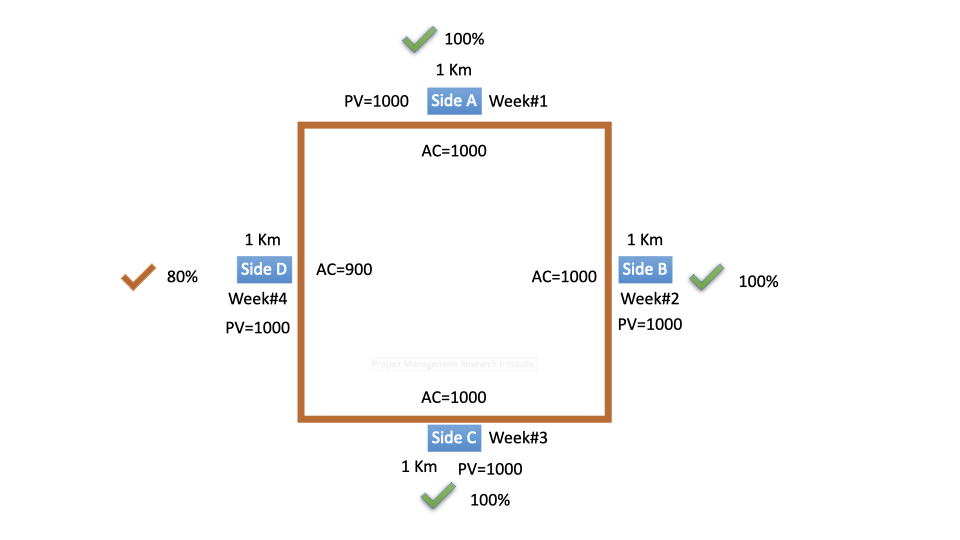Earned Value Management (EVM) is a project management technique that integrates scope, schedule, and cost performance to provide a comprehensive view of project performance. It helps project managers measure project progress, forecast future performance, and identify areas where corrective action may be needed.
Earned Value Management (EVM) helps to monitor and control project progress with respect to cost and schedule. It also helps to forecast the expected cost at completion and the date of completion (in some cases). Earned value management provides us vital information about the project like;
- How much work are we supposed to complete as per the plan till today?
- Out of it, how much did we complete?
- For the completed work, how much did we spend?
- How much is the schedule variance?
- How much is the cost variance?
- When we complete the project, how much is it likely to cost?
- When are we likely to complete the project?
- What are the probable actions we must take to control variance?
The key parameters
- How much work are we supposed to complete till today?. This is the Budgeted Cost Of Work Scheduled till the review date (BCWS). This is also known as Planned Value (PV)
- Out of the planned work, how much did we actually complete?. Budgeted Cost Of Work Performed (BCWP). This is also known as Earned Value (EV)
- For the completed work, how much did we spend?. Actual Cost Of Work Performed (ACWP). This is also known as Actual Cost (AC)
Once we know the Planned Value (PV), Earned Value (EV) and the Actual Cost (AC), then it is easy to calculate the variances;
- Schedule Variance (SV) = Earned Value (EV) – Planned Value (PV)
- Schedule Performance Index (SPI) = EV/PV
- Cost Variance (CV) = Earned Value (EV) – Actual Cost (AC)
- Cost Performance Index (CPI) = EV/AC
If Schedule Variance (SV)=0 or if Schedule Performnce Index (SPI) =1, that means Earned Value = Planned Value, hence, there is no schedule variance
If Schedule Variance(SV) is negative or if SPI is less than 1, then there is a schedule variance
If Schedule Variance (SV) is positive or if SPI is greater than 1, then the work completed is more than the planned work. That means, the project is ahead of schedule.
If Cost Variance (CV)=0 or if Cost Performance Index (CPI) =1, that idicates that the work completed is as per budget.
If Cost Variance (CV) is negative, or if Cost Performance Index (CPI) is lesser than 1, that indicates that for the work completed the project exceeded the budget
If the Cost Variance (CV) is positive, or if the Cost Performance Index (CPI) is greater than 1, thet means work is getting completed without consuming the budget.
EVM Example
Let us consider a fencing project comprising of fencing a square plot comprising of sides A,B,C and D. Each side is of length 1 Km each. and has a budget of 1000 each. The whole project is supposed to be completed in 4 weeks time. Let us assume that we are doing the review of the project after 4 weeks. The diagram below depicts the status of the project after 4 weeks;

- Planned Value = work to be completed in 4 weeks time = Sum of the planned value of sides A,B,C,D = 4000. Hence Planned Value(PV) = 4000
- Earned Value = value of work completed. Sides A,B,C are fully completed and Side D is only 80% completed. Earned Value (EV) = 3800
- Actual cost (AC) incurred to coplete this much work = 3900
- Schedule Variance (SV) = Earned Value (EV) – Planned Value (PV) = 3800 – 4000 = -200
- Schedule Performance Index (SPI) = EV/PV= 3800/4000 = 0.95
- Cost Variance (CV) = Earned Value (EV) – Actual Cost (AC) = 3800 – 3900 = -100
- Cost Performance Index (CPI) = Earned Value (EV) / Actual Cost (AC) = 3800 / 3900 = 0.974
This project has a schedule slippage and budget overrun.
Forecasting
If the nature of work remains same, and if we do not take any corrective actions how much will it cost to complete the project?
Budget At Completion (BAC) = Total Budget of the project = Sum (PV)
Estimate At Completion (EAC) = AC + (BAC-EV)/CPI
EAC = 3900 + (4000 – 3800) / 0.974 = 3900 + 200/0.974 = 3900 + 205.33 = 4105
This project will cost 4105, instead of 4000 if no corrective actions are taken
Different methods of calculating Estimate At Completion (EAC)
Estimate at Completion (EAC) is a forecasting technique used in Earned Value Management (EVM) to predict the total cost of completing a project based on current performance trends. EAC provides project managers with an estimate of the final project cost, taking into account actual performance data and adjustments for future performance expectations. There are several methods for calculating EAC, depending on the assumptions made about future performance. Here are the commonly used methods:
- EAC = AC + (BAC – EV):
- This method assumes that the project’s original budget (BAC) is still valid, and any remaining work will be completed at the original budgeted rate. It calculates EAC by adding the actual cost (AC) incurred to date to the remaining planned value (BAC – EV) for the remaining work.
- This method is suitable when the past cost performance is considered atypical, and the original budget is still expected to be accurate for the remaining work.
- EAC = AC + (BAC – EV) / CPI:
- This method adjusts the remaining work’s budget based on the project’s cost performance to date, as measured by the Cost Performance Index (CPI). It calculates EAC by dividing the remaining planned value (BAC – EV) by the CPI and adding it to the actual cost (AC) incurred to date.
- This method is suitable when the current cost performance is expected to continue for the remaining work.
- EAC = AC + [(BAC – EV) / (CPI * SPI)]:
- This method adjusts the remaining work’s budget based on both cost and schedule performance to date, as measured by the Cost Performance Index (CPI) and Schedule Performance Index (SPI). It calculates EAC by dividing the remaining planned value (BAC – EV) by the product of CPI and SPI and adding it to the actual cost (AC) incurred to date.
- This method is suitable when both cost and schedule performance are expected to continue for the remaining work.
- EAC = AC + Bottom-Up ETC:
- This method involves re-estimating the remaining work’s cost based on detailed bottom-up estimates for each remaining task. It calculates EAC by adding the actual cost (AC) incurred to date to the new estimate to complete (ETC) for the remaining work.
- This method is suitable when significant changes in project scope, requirements, or assumptions warrant a re-estimation of remaining work.
- EAC = Latest Revised Estimate:
- This method uses the most recent estimate of the total project cost provided by project stakeholders or subject matter experts. It calculates EAC by simply using the latest revised estimate of the total project cost.
- This method is suitable when new information or changes in project circumstances justify updating the total project cost estimate.
By using one of these methods to calculate EAC, project managers can obtain a more accurate forecast of the total project cost and better manage project finances and resources accordingly.
To Complete Performance Index (TCPI)
We must control the cost of the balance work to be completed to the extent of compensating for the cost overrun incurred so-far.
To Complete Performance Index (TCPI) = (BAC-EV) / BAC-AC)
TCPI = Work remaining / Funds remaining = (4000 – 3800) / (4000 – 3900) = 200/100 = 2
For the remaining work if we can maintain a CPI of 2, the project can be completed within 4000.
To interpret TCPI:
- TCPI > 1: Indicates that more efficient performance is required in the remaining work to meet the project’s objectives (budget or cost targets). This means that the remaining work needs to be completed at a lower cost per unit of work than what has been achieved so far.
- TCPI = 1: Indicates that the current project performance is sufficient to meet the project’s objectives (budget or cost targets). This means that the remaining work needs to be completed at a similar cost per unit of work as what has been achieved so far.
- TCPI < 1: Indicates that less efficient performance is required in the remaining work to meet the project’s objectives (budget or cost targets). This means that the remaining work can be completed at a higher cost per unit of work than what has been achieved so far.
Project managers use TCPI to assess whether the project’s performance needs to improve, remain the same, or can be relaxed to meet budget or cost targets. It helps guide decision-making and resource allocation to ensure successful project completion within constraints.
The ‘S’ Curve

Rules of Credit
Rules of Credit in EVM
- Credit for Completion: Only the work that has been formally completed and validated earns credit. This means that partial work may not count towards earned value until it reaches a predetermined milestone or acceptance criteria.
- Performance Measurement: Credit for earned value is usually measured based on the percentage of completion of deliverables. You might use methodologies such as:
- 100% Rule: Full credit for a task is gained when it is completely finished.
- 50/50 Rule: Half the credit is assigned when the task begins and the other half upon completion.
- Weighted Milestones: Assigning different levels of credit based on the complexity and significance of different phases of work.
- Time Periods: Credit should be assessed at regular intervals (e.g., weekly, monthly) to track project performance and ensure timely adjustments can be made if necessary.
- Reporting: Accurate reporting of earned value is crucial. Misrepresenting the credit for work performed can lead to incorrect interpretations of project health and forecasts.
Conclusion:
EVM provides project managers with valuable insights into project performance, allowing them to identify schedule and cost variances, assess project efficiency, and take corrective actions if necessary. By leveraging EVM, project managers can make informed decisions to ensure project success and meet stakeholder expectations.

